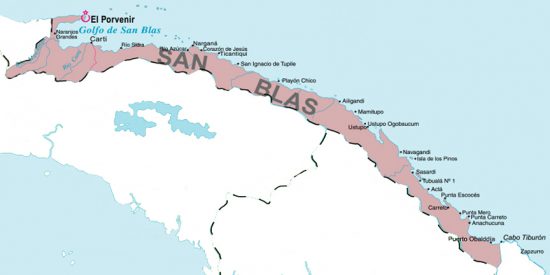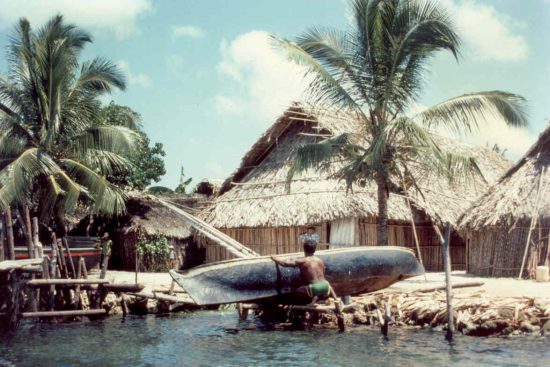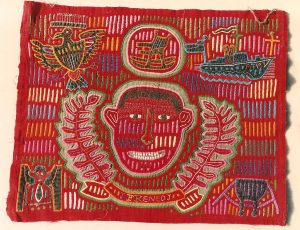The Cunas strictly regulated all commercial trade in San Blas. The San Blas Comarca is an autonomous region of the Republic of Panama, very similar to an United States Indian reservation, but with the added right to make trade agreements and treaties with other countries, and is not subjected to any oversight by anything like a Bureau of Indian Affairs, as we have in the states.

The Cunas have three large, wooden hulled, motorized trading vessels that were operated by island cooperatives, and were used mainly for bringing supplies and manufactured goods from Colon to each of the islands on a bi-weekly basis. Besides these three vessels, there was a small fleet of canoas, old, wooden sloops that sailed out of Colombia and plied the waters of the San Blas archipelago buying coconuts from the Cunas and carrying a certain amount of trade goods that the Sailas allowed them to bring to the islands.
The canoa would tie up to the dock at one of the islands, and the captain would ask the Cuna in charge of the dock permission to buy coconuts. The price per coconut had already been established for the season by prior agreement arrived at over negotiations between the Sailas and the Colombian copra processor’s representative, so if that particular captain didn’t have any outstanding debts, or previous problems on that particular island, a small fee would secure him rights to remain tied up to the dock for the day and buy any coconuts that the villagers may bring to him for sale. One by one, Cunas would approach the sloop tied up to the dock and offer his pile of ten or twenty coconuts. A dollar, or two, would change hands and the Cuna would toss the nuts, one by one, to one of the crewmembers aboard. The crew members were not allowed on the dock without a special written pass from the Sailas, and even with the pass, crew members were never allowed to set foot on the island after dusk. Usually, no more than two of the crew members would be issued a day pass and permission to carry their small tote-bags of trade goods door-to-door around the island. Consisting mainly of printed cloth, glass beads, and cheap rubber sandals, these trade goods had to be approved by the Sailas before the Colombians could make their rounds.

A few of the sea passages between the islands could be pretty dangerous in bad weather, but approaching some of the coastal communities during high winds was the worst. Mansukun was one community that had a particularly treacherous entrance to its beach. As we approached from offshore, the long, slow swells began to reach the shallow, rocky reef that stood slightly off the beach, and they became much steeper and started to break. I could see the white combers that marked the mouth of the channel through the rocks that we would soon be trying to enter with Don Tiki. This was always a tense moment. We were essentially trying to “surf” a forty-five foot long log through the crashing waves, trying not to let the bow stick and the stern swing around, leaving us crosswise and vulnerable to capsizing in the turbulent maelstrom. Many a sailor has lost his life as his piragua turned turtle in the waves and he was unable to avoid being knocked unconscious by either the piragua, loose cargo, or the hard seafloor.
Lino climbed over the gas drums and took a seat next to me on my bench. We were getting real close to the breakers now. From this point on, Lino and I were basically mobile ballast. Soon, Herminio would begin to shout orders to us, moving either one or both of us forward, towards the stern, or amidships, as needed to keep the bow from digging in. We had to work as a team, and be ready to scramble up and over the gas drums quickly. Now, it was time! “Ric. Bow!” he yelled, and I scrambled over the barrels and squatted in the piragua’s bow as it rose up high into the sky, sticking a good ten feet out of the water as it rode up on top of the first breaking wave. I could look back down the length of the piragua and see Herminio, forty-five feet back and some fifteen-feet below me. Lino was still positioned amidships. “Now, back with Lino!” Herminio shouted, and I scrambled back to my spot next to Lino as the bow began to fall rapidly as the center of balance of the piragua changed when it passed over the crest of the first breaking wave. The bow was now starting to tilt down and the stern began to rise. “Both back!” came the command, and Lino and I both made our way quickly towards the stern, and crouched down. This was the tricky point. If the piragua began to surf down the face of the breaker too quickly, and the bow penetrated the wall of water in front of us, we were toast. As we gripped the top-rails, the piragua began its slide down the face of the breaker, gaining speed. The bow began to dig in, and we all leaned back towards the stern as far as we could, three minds intent in willing the four-ton log to keep from digging in any further. Just as it looked as it was going under, Herminio cut back on the throttle, and the bow rose up just enough so that we began to ride up over the next breaker. “Lino, mid! Ric, bow!” We began the whole maneuver all over again for the second wave. We had four waves more to go, each one a little worse than the last, until we would pass into the calmer waters near the beach.
We always tried to arrive at a place to unload and sleep when there was still light; unloading a canoe and making camp at night was awkward at best, dangerous at worst. It was always preferable to get a good look around a place and get your bearings in the daytime, before you had to negotiate your way in the dark in new surroundings. Once, because of engine problems, we ended up arriving at a village late at night. It took us a couple of hours to unload and set up our gear, and we hadn’t had time to fix a meal. Just as we were hanging up our hammocks, an old man came in carrying a battered old tin plate that was piled high with fist-sized chunks of grey, boiled meat. “For you.” he had said, before setting the plate down. “Eat now. We talk later.”
Herminio, Lino and I had sat cross legged next to the plate and ate what we could. It was tough as shoe-leather, and had a strong, gamey flavor. Most of the chunks were gristle, but there had been enough meat to quiet our growling stomachs. A little later, the man had returned, bringing two young women along so they could see the two strange visitors up close. “Thank you very much for the meat.” I had told them. Meat was hard to come by in the jungle. Most people think of the rainforest as being full of all kinds of game animals, but that’s not the case. Neke, conejo-pintado, and capybara, all large rodents, made up the bulk of the red meat that the hunters turned up. Deer, javalina, and other large mammals were few and far between. “What kind of meat was it?” Herminio had asked. Moli was the reply. Moli was the Cuna name for a tapir. The tapir was a large animal, similar to a long-legged pig, with a slightly prehensile nose kind of like an elephant’s trunk, but much shorter. They were solitary animals that were scattered sparsely throughout the lowland rainforests of Panama, and it wasn’t often a hunter would run across one, let alone be able to kill it. “I’m impressed!” I said, knowing a three hundred pound tapir would provide enough meat for the entire village for several days. “Who killed it?” “We don’t know,” he said, “We think it may have been an alligator. We found it floating down the river a few days ago.” Another good reason to set up camp in daylight: You get to cook your own food!
There are lots of sharks in San Blas, and lots of interaction between them and the Cunas. Although the Sailas have made it illegal to scuba dive within the Comarca without special permission (which is rarely given, due to the high number of diving accidents in the past), Cunas regularly free dive for lobster, octopus, and fish on and around the thousands of reefs that surround the islands. Hauling a net bag of bleeding fish and squeaking lobsters behind you isn’t much different than “chumming” for sharks, and it’s not unusual to see Cunas that are missing a hand or a foot that was lost to the bite of a reef shark. Bull sharks are the worst offenders, but white tips, black tips, and even the occasional tiger shark have attacked divers here.

El Porvenir Island is the north-westernmost inhabited island in the San Blas archipelago, and serves as one of the region’s seats of administration. It is fairly small and doesn’t host a large village population like a lot of the islands. Although it has a few permanent residents, it mainly serves as a buffer zone between the Cunas and outsiders. When cruise ships come to San Blas, this is where they come. They anchor off shore, and lighter passengers in to Porvenir to buy trinkets and to take photos of the “natives”. Before the cruise-liner arrives, hundreds of Cunas paddle and sail their ulus, or small dugout canoes, from neighboring inhabited islands and set up small booths for the day where they will sell their wares. Having tourists arrive directly to the inhabited islands would create too much tension, say the Sailas; isolating them on Porvenir still provides the tourists with the feeling of “experiencing” a Cuna village, and the Cunas get cash for their handicrafts without the bother of dealing with foreigners wandering around a village where they are trying to live a very structured tribal existence.



Porvenir also is home to the office of the Comarca’s Governor, or Intendente. In the morning, Cuna officials commute by canoe to the small concrete block building to hear petitions from Cunas and non-Cunas alike. To enter San Blas, this is where you must present a passport, be vouched for by a resident Cuna, and pay a small fee. If you are a Cuna, wishing to leave the islands on an extended trip away from home, you must register with the administration, show you are in good standing with your home village, and agree to pay a small daily “absence” tax for every day you are away from San Blas.
Toilet facilities in San Blas are usually just small cane-walled shanties that hang precariously at the end of a shaky two-foot wide piers made up of driftwood planks tied and nailed together like some Rube Goldberg contraption. Inside the shanty is a five gallon bucket of water with half of a dried gourd floating in it next to a hole in the floor. The bucket of water is for your shower. You know what the hole is for.
We had been staying at a friend of Lino’s house, and he had a small, rickety wooden pier out back of his house, and the cane-walled outhouse/bath house was perched at the far end of it. Being six of us sleeping in the house, there was a kind of rush hour traffic jam for the use of the facility when we all got up, so we formed a line on the bench outside against the back wall of the house, facing the pier as we waited our turn to use the outhouse at the end of the pier. There was a lot of good natured kidding as we sat there like a group of judges at an Olympic skating event, rating the size and quantity of the efforts produced by the occupant of the outhouse as it splashed into the water. We unanimously awarded Omar’s oldest son first prize.
Stay tuned for more about San Blas, later on…
copyright 2017, Ric Hajovsky
